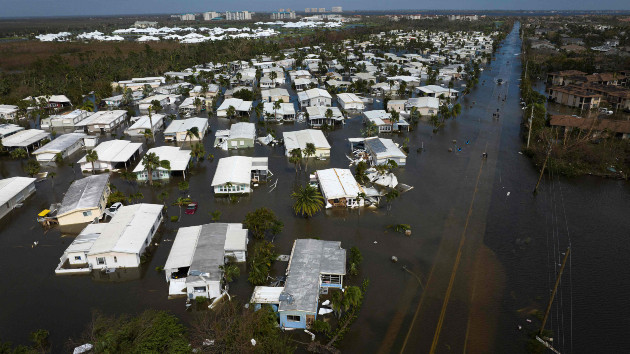(NEW YORK) — Hurricane Ian has passed through Florida, leaving a path of destruction in its wake as it now targets the Carolinas.
Florida Gov. Ron DeSantis called the impacts and damage from the storm “historic” based on initial assessments.
“There’s going to be a lot more assessing that goes on in the next couple days ahead, but I think we’ve never seen a flood event like this,” he said during a press briefing Thursday.
As damage assessments are underway, many residents may be unable to return to their homes due to flooding, curfews or damaged infrastructure.
“It’s really frightening to go through a hurricane, I’ve been through a lot,” Dennis Smith, planner in residence in Florida State University’s Department of Urban and Regional Planning, told ABC News. “It can be pretty devastating to have to sit it out and wait and wonder what happened to your house.”
Smith advised those impacted to try to have as much patience as possible, both for their safety and the realities of the recovery process.
“I think that the first word is a little bit of patience and a lot of caution in reentry,” he said. “It’s gonna be a long process…People have to be really careful because the conditions are dangerous.”
As those impacted by the storm begin the long recovery process, they may be able to rely on insurance, or a combination of insurance and federal aid.
First call: Insurance provider
Homeowners should reach out to their insurance provider “right away” to let them know they’ve been affected, Smith said.
DeSantis advised that people take photos of the damage and floodwater lines.
A potential shock for homeowners is if they don’t have flood insurance, since homeowners insurance doesn’t cover flood damage, Smith said.
“Banks will require you to have flood insurance if you have a mortgage and you’re in a flood zone,” he said. “But we know with catastrophic floods like this, flooding can occur outside of flood zones.”
There may also be costs that go beyond insurance coverage, such as downed trees, he noted.
‘Insurance villages’
In impacted counties, Florida is in the process of setting up “insurance villages” at disaster recovery centers with upwards of 25 carriers, where people can go and file claims, state officials said.
“They will start writing checks initially, that will be living expense money. This will be the dollars just to help people go find a place to live, sustenance dollars,” Jimmy Patronis, Florida’s chief financial officer, said during a press briefing Thursday. “Then you’ll be signed up where adjusters will come and inspect the damage.”
Beware of scams
Patronis warned Floridians to beware of scammers at this vulnerable time, such as people trying to sign up construction management contracts.
“They’re gonna come in like a bunch of locusts,” he said. “If it sounds too good to be true, it is.”
He advised people to make their first call to their insurance agent or carrier, and to contact his office with any issues.
“If your carrier doesn’t want to work with you, that’s when you call my office and we’ll take them to task,” he said.
Reducing future losses
When working with their insurance carrier, homeowners should discuss next steps they can take to help reduce future losses from natural disasters, such as by putting a tarp on their house, Smith said.
“There might be opportunities or guidance to…prevent future damages,” he said. “That’s really an important step that people need to do.”
Small Business Administration loans
Those who find themselves uninsured or underinsured may be able to get financial assistance.
Small Business Administration loans are the “first line of defense” for homeowners, Smith said.
Those living in a declared disaster area who have had damage to their home or property may be eligible for a low-interest loan. Homeowners or renters in over a dozen counties in Florida are eligible due to Hurricane Ian. Homeowners can apply for up to $200,000 to replace or repair their primary home, while renters and homeowners can borrow up to $40,000 to replace or repair personal property, such as furniture, appliances, cars and clothing, damaged or destroyed.
FEMA disaster assistance
FEMA offers assistance for damage and losses not covered by homeowners, renters or flood insurance, as well as other disaster-related expenses such as temporary lodging.
Federal funding has been made available to people in over a dozen counties due to Hurricane Ian.
“Disaster assistance may include financial help with temporary lodging and home repairs, as well as other disaster-related expenses,” FEMA said in a statement.
Those in affected areas can request up to $37,900 for home repairs, such as for the roof, critical utilities, windows and doors, and another $37,900 for lost property, if not covered by insurance, President Joe Biden said during an address from FEMA headquarters on Thursday.
Financial assistance is also available to homeowners and renters to rent temporary housing while their home is unlivable, or reimbursement of hotel expenses if their home is not accessible or there’s a utility outage, if not covered by insurance.
Over 8,700 people have already registered with FEMA, DeSantis said Thursday night.
FEMA assistance cannot be used toward losses already covered by insurance, so applicants are first encouraged to file a claim with their insurance company immediately. They should also take photos of their damaged home and belongings.
People can register at DisasterAssistance.gov or by calling 800-621-3362.
Copyright © 2022, ABC Audio. All rights reserved.












